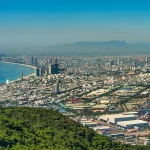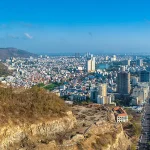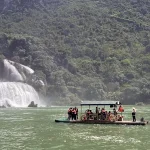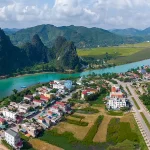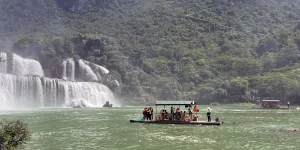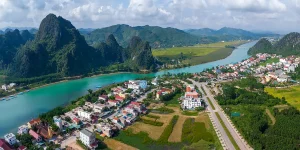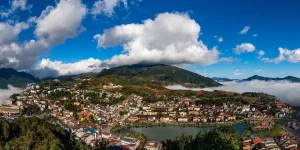Vietnam has seen a steady rise in international visitors over the years, with over 12.6 million tourists arriving in 2023 — a massive jump from post-pandemic recovery years. And it’s easy to understand why: Vietnam offers a powerful mix of natural beauty, culture, and affordability.
But here’s the thing — most travelers stick to the same well-trodden path. Whether you’re backpacking or on a short vacation, chances are your route follows the familiar line from Hanoi down to Ho Chi Minh City — with the usual stops in Ha Long Bay, Hue, Da Nang, Hoi An, and Mui Ne along the way.
There’s nothing wrong with these spots — they’re popular for a reason. But Vietnam has much more to offer beyond the mainstream. While the top destinations are getting crowded, other equally stunning places remain quiet, raw, and undiscovered.
In this guide, we shine a light on Vietnam’s hidden gems — lesser-known towns, quiet corners, and off-the-grid natural escapes. These are not places you’ll find in every Vietnam travel brochure. Some are remote and take effort to reach, while others are surprisingly close to major cities but often overlooked.
For each destination, we’ll cover what makes it worth visiting, what you can do there, and how easy it is to reach. So if you’re looking to extend your itinerary and step off the beaten path, this is your invitation to explore the side of Vietnam most tourists miss.
Let’s begin in the North — where the mountains hide more than just misty views.
Northern Vietnam’s Hidden Treasures

Cao Bang Province
Cao Bang is in Northeast Vietnam, near the Chinese border. It’s best known for Ban Gioc Waterfall — the largest in the country. But the province offers much more than one landmark. The landscape features limestone mountains, river valleys, and winding roads that cut through sparsely populated countryside.
Travelers can explore Nguom Ngao Cave, a large karst system that stretches over two miles (3 km). Its chambers are filled with stalactites and stalagmites. Another highlight is Angel Eye Mountain — a circular rock formation with a wide hole. It’s best viewed from the valley floor and can be reached by motorbike or with a local tour.
In addition to its natural landscape, the region is dotted with craft villages. Tay and Nung communities continue to produce handwoven textiles, incense, and knives using traditional techniques. You’ll also come across wooden watermills near Pac Bo and surrounding villages — still functioning today for irrigation.
How to get there:
Cao Bang is about 175 miles (280 km) from Hanoi. Sleeper buses depart daily from My Dinh Bus Station, and the journey takes 7–9 hours. Roads are mountainous but paved. Hiring a motorbike or car locally is recommended to reach points of interest across the province. For more details on how to move around the country, check our Vietnam Transportation Guide.

Mu Cang Chai (Yen Bai Province)
Mu Cang Chai is a rural district in Yen Bai Province, known for its steep, layered rice terraces carved into mountain slopes by Hmong farmers over generations. From late September to early October, the terraces turn golden during harvest, drawing photographers and domestic travelers. Outside of harvest season, the region stays quiet and scenic. You’ll find stilt houses, forested hills, and narrow mountain roads linking small villages.
The area is ideal for trekking and motorbiking, especially along Khau Pha Pass, one of Vietnam’s highest mountain passes. The trails and roads lead through villages, where agriculture and textile weaving remain daily routines.
One of Mu Cang Chai’s most unique features is the real homestay experience. Visitors stay with local families in simple wooden houses, often with no internet and only basic amenities. These are not tourist performances — daily life here continues as it has for decades. Guests can observe cooking over wood fires, farming by hand, and community gatherings that feel untouched by outside influence.
How to get there:
Mu Cang Chai sits between Hanoi and Sa Pa, making it a common stop for those driving or riding a motorbike through the north. Getting here by public transport takes more effort. Most travelers take a long-distance bus to Nghia Lo, then continue by motorbike or shared minivan. Roads are paved but winding.

Y Ty (Lao Cai Province)
Y Ty sits at over 6,500 feet (2,000 meters) above sea level in Lao Cai Province, near the Chinese border. Its high altitude and isolation create a unique landscape of cloud-covered peaks, seasonal rice terraces, and remote ethnic villages. The commune remains far less visited than nearby Sa Pa, making it one of Vietnam’s most quiet and untouched highland regions.
Visitors come for the fog-filled mornings, the panoramic views of stepped rice fields, and the distinctive earthen-walled houses. During harvest season (typically September), the golden terraces are striking. In winter, snowfall is possible — a rare sight in Vietnam. The region also offers trekking routes through mountain trails and villages.
Y Ty is ideal for travelers interested in photography, cultural discovery, and seeing a side of Vietnam that remains deeply rural and unscripted.
Good to Know
Foreign tourists need a border permit to stay overnight in Y Ty, as it lies within a restricted frontier zone. Permits can be arranged through the Lao Cai Immigration Office or a licensed travel agency. Without it, accommodation may be denied.
How to get there:
Y Ty is located about 225 miles (360 km) from Hanoi. Most travelers go to Sa Pa first, then continue by motorbike or shared van (around 4–5 hours). The road winds through steep and rugged terrain, especially near A Lu and Ngai Thau villages, and conditions can be poor during the rainy season. It’s best suited for travelers with extra time or prior experience with remote travel.

Bat Trang (Hanoi outskirts)
Bat Trang is a traditional pottery village just outside Hanoi, with over 700 years of ceramic-making history. It’s an easy half-day cultural detour where visitors can explore working pottery studios, try spinning clay by hand, and visit the Bat Trang Ceramic Museum, which blends contemporary architecture with craft heritage.
One of the highlights is the village market. Stall after stall is packed with every kind of ceramic you can imagine — from tiny teacups and hand-painted plates to large vases, wall tiles, and decorative sculptures. It’s not just for tourists; locals shop here too, which keeps prices fair and the selection authentic.

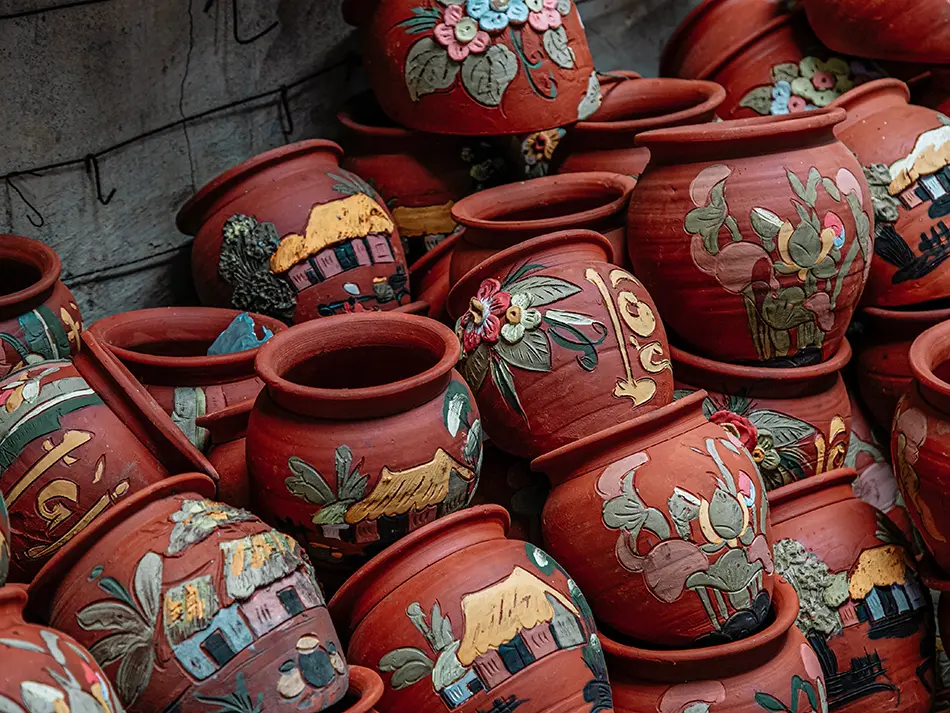
How to get there:
Bat Trang is only 8 miles (13 km) from central Hanoi. It’s easy to reach in under 30 minutes by Grab, taxi, or bicycle. Public bus 47 also runs frequently between Long Bien and the village. It’s a convenient trip for travelers looking to see traditional craftsmanship without leaving the capital region.
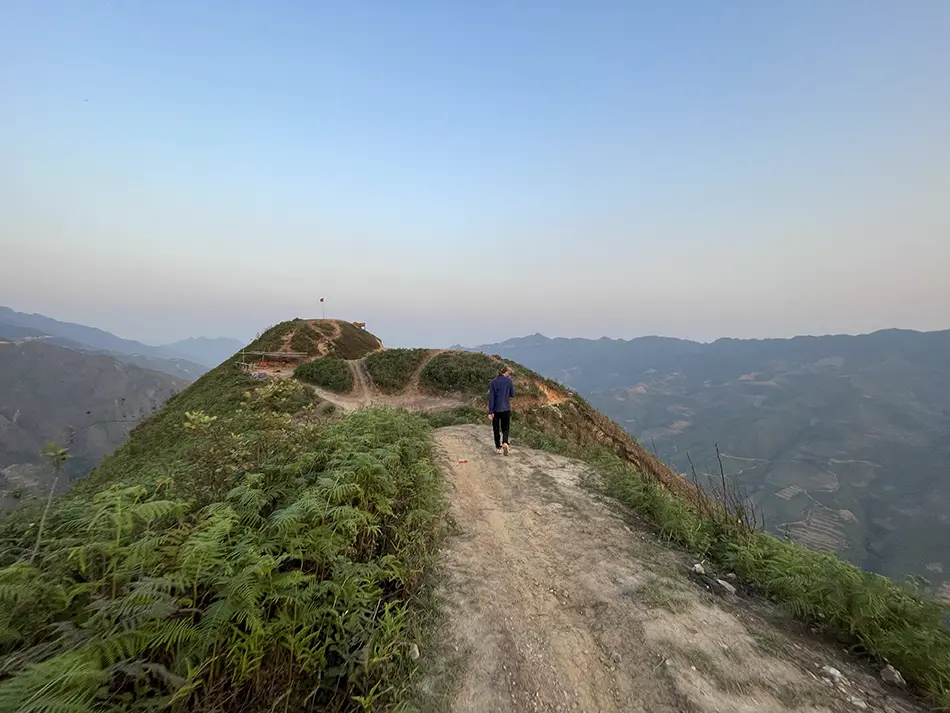
Ta Xua (Son La Province)
If you’re chasing clouds — literally — Ta Xua is the place. Nicknamed the “cloud hunting capital” of Northern Vietnam, this mountain ridge is famous for its high altitude and thick morning mists that roll between the peaks like slow waves. Most come to hike the iconic “Dinosaur Spine” — a narrow trail along a ridgeline that offers panoramic views and a serious adrenaline rush.
Ta Xua is also popular with motorbike travelers who enjoy winding mountain roads. Outside of sunrise and hiking, the area is quiet, scenic, and ideal for stargazing at night. There are no major tourist crowds or packaged tours — you’ll mostly meet Vietnamese nature lovers and weekend adventurers.
How to get there:
From Hanoi, it’s about 125 miles (200 km). The most common route is to drive or take a sleeper bus to Bac Yen, then go the final stretch by motorbike or taxi. Roads are narrow and steep but in good condition. Expect about 6–7 hours of total travel time.
Central Vietnam Offbeat Spots
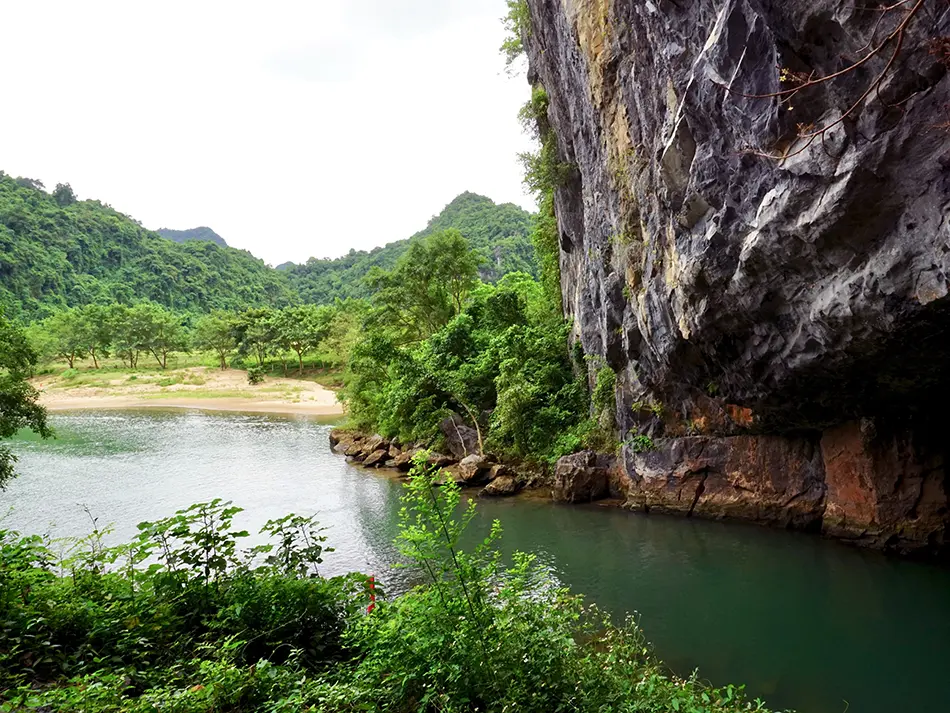
Phong Nha-Ke Bang National Park (Quang Binh Province)
While Phong Nha is slowly gaining recognition, it’s still one of the most underrated places in Vietnam for adventure travel. This UNESCO-listed national park is home to the largest cave in the world — Son Doong — along with hundreds of other caves, underground rivers, and limestone karsts.
It’s a paradise for explorers. You can go cave trekking, kayaking, or join a guided multi-day expedition through jungle and river valleys. Some caves like Paradise Cave and Phong Nha Cave are easily accessible, while others require permits and guided tours. Outside the caves, the area is peaceful and authentic, with small homestays, local farms, and rice fields.
How to get there:
Phong Nha is about 310 miles (500 km) south of Hanoi. The nearest city is Dong Hoi, which has a small airport and train station. From there, it’s a 45-minute drive to the park. You can fly, take a train, or use sleeper buses to reach Dong Hoi from major cities. Roads are good and access is straightforward.

Kon Tum (Central Highlands)
Tucked away in the Central Highlands, Kon Tum remains largely off the tourist radar. It’s a culturally rich area where visitors can explore Bahnar and Jarai ethnic villages, wooden stilt churches, and peaceful countryside. The Wooden Church of Kon Tum, built in 1913, is one of the town’s most iconic landmarks.
What makes Kon Tum special is its quiet authenticity. You can walk along the Dak Bla River, visit local orphanages and traditional villages with long communal houses, and enjoy the cool highland climate without the crowds of Da Lat.
How to get there:
Kon Tum is about 155 miles (250 km) from Da Nang and 280 miles (450 km) from Ho Chi Minh City. There’s no direct train, but you can fly to Pleiku Airport (25 miles / 40 km away) and then take a taxi or bus to Kon Tum. The area is best explored by motorbike or car.

Tuy Hoa (Phu Yen Province)
Vietnam’s central coast has no shortage of quiet towns that international tourists often skip — but Tuy Hòa stands out for offering more than just empty beaches. While still under the radar, it combines relaxed coastal living with unique geological landmarks, freshwater lagoons, and a slower, local rhythm that hasn’t been reshaped by tourism.
Just outside the city, you’ll find Ganh Da Dia (Da Dia Reef) — a striking volcanic rock formation of hexagonal basalt columns, rarely found anywhere else in Southeast Asia. The area also offers calm, sandy beaches like Bai Xep, scenic drives along the coast, and fresh seafood at O Loan Lagoon, where small local eateries sit right over the water.
If you’re looking for a place to experience coastal Vietnam without the noise of large-scale resorts, Tuy Hòa is a practical and rewarding option. It’s one of many lesser-known beach towns, but we’ve included it here for its geological interest, proximity to nature, and low-key charm.
How to get there:
Tuy Hoa has its own domestic airport (TBB) with flights from both Hanoi and Ho Chi Minh City. It’s also located along the Reunification Railway, making it easy to reach by train. From Da Nang, it’s about 200 miles (320 km) south — around 6–7 hours by train or bus. Once in Tuy Hoa, renting a motorbike is the best way to reach nearby beaches, reefs, and viewpoints.
Lesser-Known Escapes in Southern Vietnam
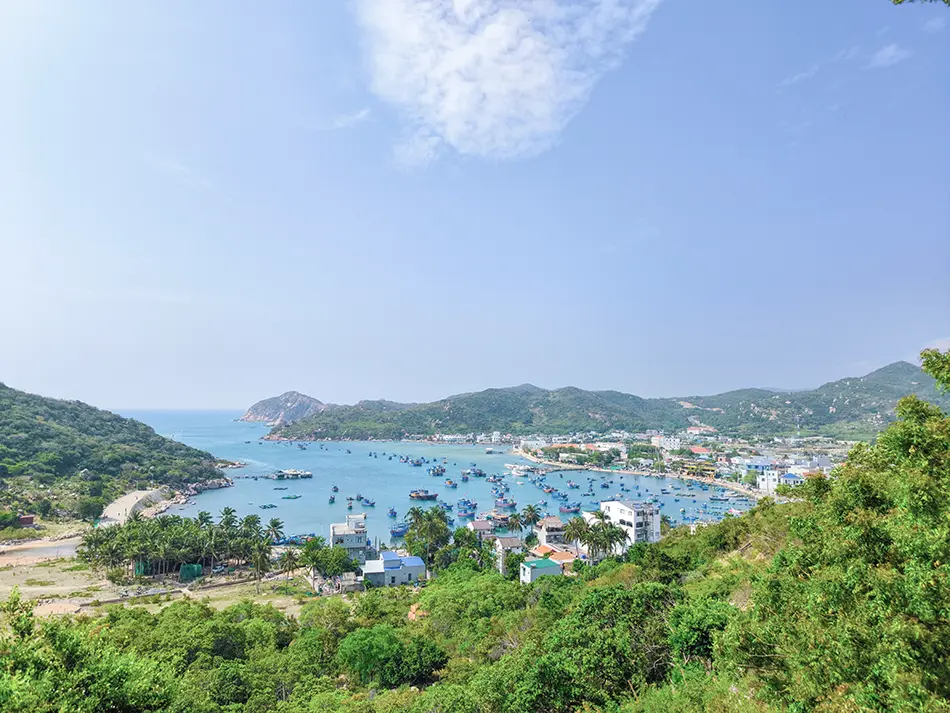
Vinh Hy Bay & Nui Chua National Park (Ninh Thuan Province)
Vinh Hy Bay offers a quieter coastal experience with access to both marine and mountain ecosystems. The bay is a working fishing port, bordered by coral reefs and calm waters ideal for snorkeling, boat trips, and kayaking. Just inland, Nui Chua National Park protects one of Vietnam’s few dry forest ecosystems — with coastal trails, native wildlife, and views over the East Sea.
One of the reasons we’ve included Vinh Hy on this list is because of the roads that surround it. The stretch from here to Nha Trang is considered one of the most scenic coastal drives in Vietnam, with sweeping sea views and minimal traffic.
How to get there:
Vinh Hy is located about 25 miles (40 km) northeast of Phan Rang-Thap Cham, a city with rail and bus connections to major hubs. From there, you can rent a motorbike or take a taxi along the scenic coastal road.

Con Dao Islands (Ba Ria–Vũng Tau Province)
A former prison colony turned conservation zone, Con Dao is one of Vietnam’s most remote and least developed island groups. While it doesn’t have the postcard beaches of Thailand, the island offers quiet stretches of coastline, forest-covered hills, and important sea turtle nesting grounds protected by national park regulations.
Visitors come to dive in coral-rich waters, explore Con Dao National Park, or visit the Con Dao Prison Museum, which documents the island’s role during the French colonial era and Vietnam War. The historical sites are stark but powerful, contrasting with the natural calm that now defines the area.
Due to its limited infrastructure and restricted development, Con Dao has largely avoided the high-volume tourism seen in other parts of Vietnam. It’s best suited for travelers looking for quiet exploration, nature walks, and historical context in a coastal setting — not beach bars or nightlife.
How to get there:
Con Dao is located about 143 miles (230 km) from Ho Chi Minh City. The fastest and most reliable option is a domestic flight (about 45 minutes). There’s also a ferry from Vung Tau, though sea conditions can affect schedules. Once on the island, you can get around by motorbike rental or electric shuttle, both widely available near the town center.
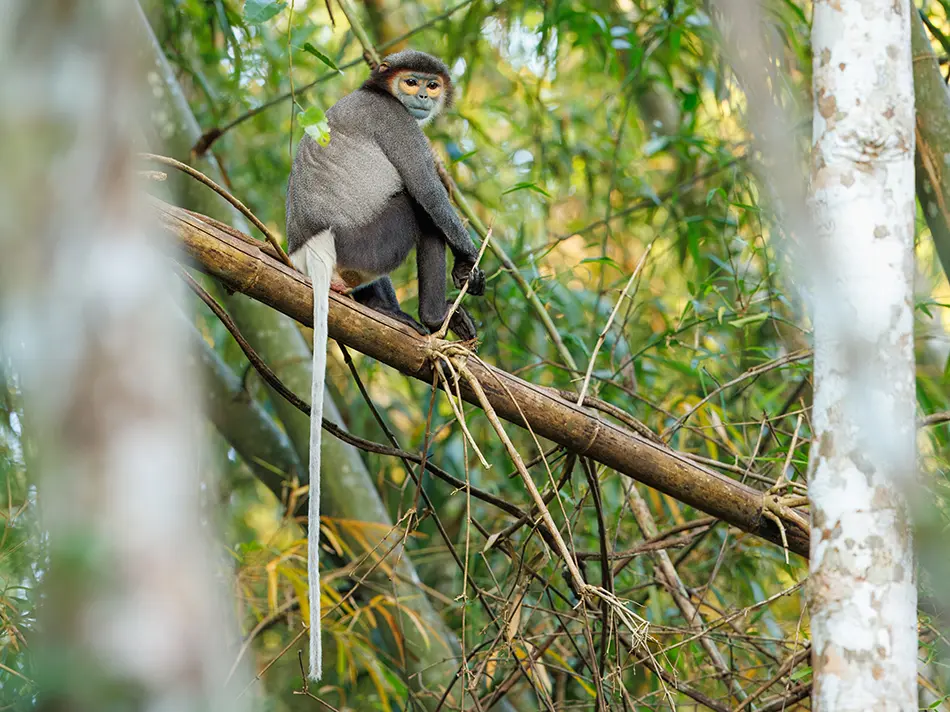
Cat Tien National Park (Dong Nai Province)
If you’re looking to experience Vietnam’s jungle ecosystems without flying to the far north, Cat Tien is one of the most accessible options. This Biosphere Reserve spans lowland tropical forest, wetlands, and grasslands. It’s home to gibbons, elephants, and crocodiles — though most wildlife stays deep in the park, so sightings aren’t guaranteed.
Visitors can join guided night safaris, take a boat along the Dong Nai River, or trek to quiet spots like Crocodile Lake or Ben Cu Rapids. The park also hosts the Dao Tien Endangered Primate Species Centre. This facility rehabilitates rescued gibbons and langurs before returning them to the wild. It’s a meaningful stop for anyone interested in conservation.
Cat Tien is ideal for travelers wanting a low-impact, slow-travel nature experience within reach of Vietnam’s southern destinations. It offers a quiet, immersive break from cities or beach towns, with rustic accommodation options near the park entrance.
How to get there:
Cat Tien is about 95 miles (150 km) northeast of Ho Chi Minh City. The easiest way to reach it is by direct minibus or private car, with a travel time of around 4 hours. Several eco-lodges and guesthouses near the park gate offer pick-up services and can help arrange tours inside the park. Public buses also run to nearby towns like Tan Phu, but connections from there are limited.
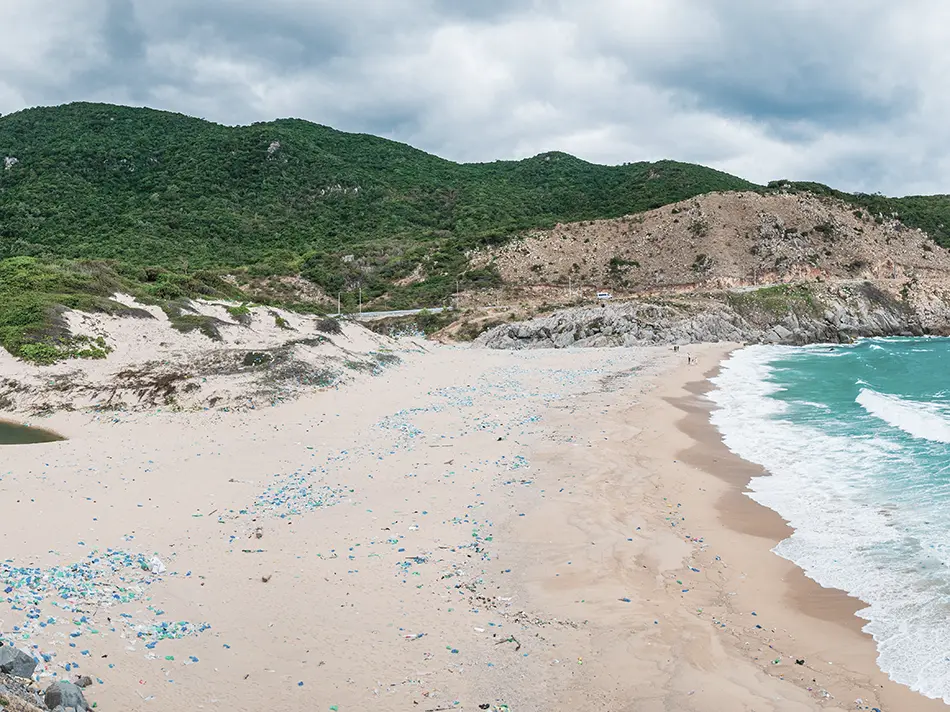
A Brief Thought on Vietnam’s “Secret Beaches”
It’s tempting to believe that somewhere along Vietnam’s 2,000-mile (3,200 km) coastline, there’s an untouched paradise waiting to be discovered. And on the surface, it might seem that way. From scenic roads near Nui Chua to remote coastal provinces like Phu Yen or Binh Thuan, there are plenty of empty-looking beaches that rarely appear on tourist maps.
But the truth is more complicated — and less glamorous. While undeveloped beaches do exist, they’re often heavily affected by plastic pollution. It’s common to find long stretches of sand partially or even completely covered in trash. This is especially true outside managed or resort-maintained areas.
Most of Vietnam’s consistently clean beaches today are the ones maintained by private hotels or resorts. While that limits spontaneity and freedom, it reflects the current reality of coastal management in the country.
We say this not to discourage exploration — but to help you set realistic expectations. If you want clean, swimmable beaches, check local conditions carefully. It’s safest to stick to places where waste is regularly collected and managed.
We hope future efforts in waste management and community-led cleanups can help turn the tide. Until then, let’s stay curious, but also informed.
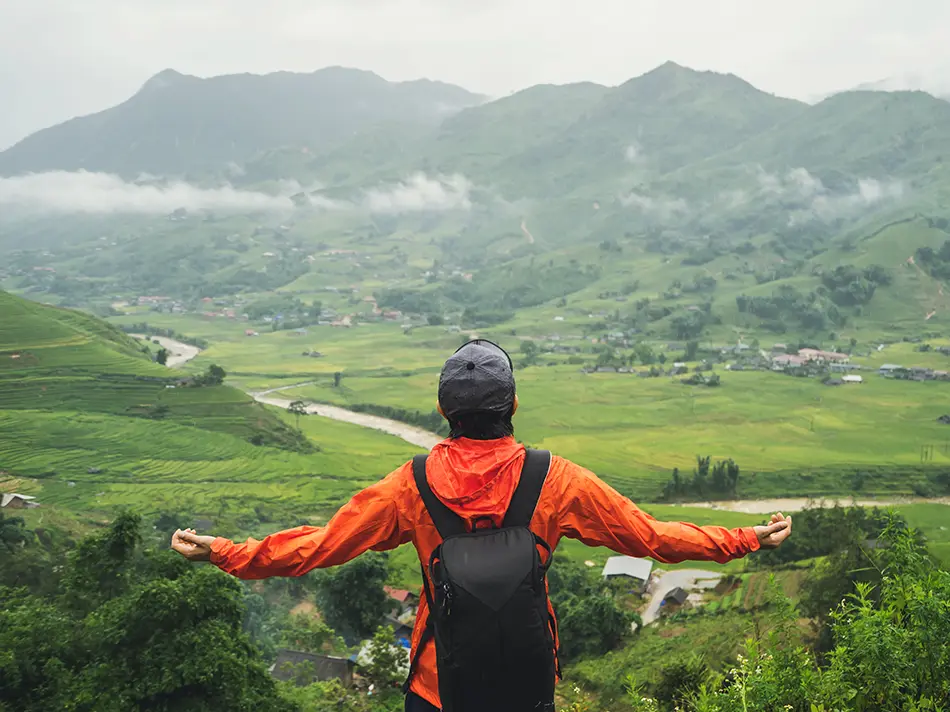
Final Thoughts on Vietnam’s Hidden Gems
Going beyond the typical Vietnam route isn’t just about avoiding crowds. It’s about seeing the country in a deeper, more personal way. Adding these destinations to your itinerary takes a bit more planning. Roads might be rougher, transport less direct, and Wi-Fi patchier. But that’s part of what makes the experience memorable. You’ll find fewer photo ops made for Instagram, and more moments that feel real, spontaneous, and genuinely yours.
If you have the time and curiosity, we highly recommend weaving a few of these hidden gems into your next trip. You don’t need to skip the highlights — just go a little further, stay a little longer, and see what’s waiting beyond the usual.
From all of us at Guides and Stories, we hope this guide helps you travel smarter. Travel slower. And with a bit more wonder.

